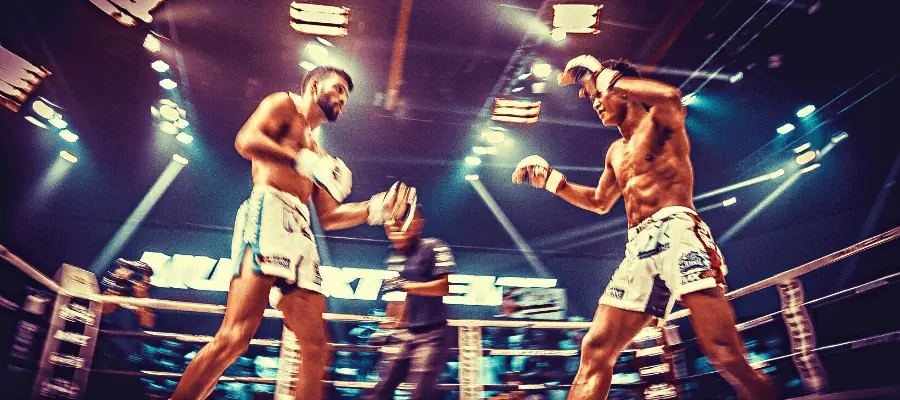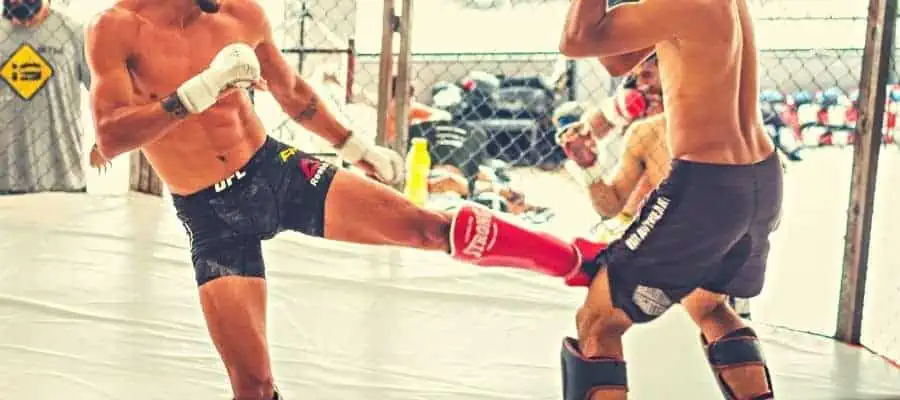In MMA, there has always been a debate on whether size really matters or not. Many people believe that being bigger and heavier provides a clear advantage in the sport. However, it’s important to understand that size would not play such a significant factor if the fighters weren’t all on top of their game.
In MMA, size can be a crucial factor in determining the outcome of a fight. Generally, larger and heavier fighters tend to be more successful in taking down opponents, have a stronger striking power, and absorb punishment better than smaller opponents.
Most MMA fighters have excellent technique, endurance, and reaction time. They have trained extensively in various martial arts, including Brazilian Jiu-Jitsu, Muay Thai, boxing, and wrestling. They have honed their skills to a point where they can take on an opponent of any size. But what if both fighters are equally skilled? That’s when size can start to play a significant role.
Weight And Height Matter In Martial Arts

Size plays an important role in MMA because it affects a fighter’s strength, power, and ability to control their opponent. Generally, a larger and heavier fighter can use their size to overpower their opponent, throw heavier strikes, and control the fight with grappling and wrestling.
They also have more mass to absorb punches and kicks, which can be a significant advantage. While smaller fighters may have faster footwork and be more agile, they often have to work harder to get inside and strike their larger opponent. However, this is not to say that size is the only determining factor in MMA.
Technique, experience, and strategy can also play crucial roles in the outcome of a fight, and smaller fighters have been known to defeat larger opponents with their skills and quickness. Overall, while the size can provide an advantage in MMA, it is not the sole determinant of victory.
Who Has The Advantage: Power
In MMA, power is essential as it can cause significant damage to an opponent. When it comes to power, the larger fighter often has an advantage. A larger fighter has more mass behind their strikes and can generate more force. The heavier fighter’s punches and kicks can be more devastating than those of a smaller fighter.
However, it is important to note that technique and accuracy are also crucial in generating power. A smaller fighter with proper technique can still generate a lot of power and potentially cause significant damage to their opponent.
Who Has The Advantage: Technique
The technique is crucial in MMA, allowing fighters to execute strikes and submissions with precision and effectiveness. When it comes to technique, size is not necessarily a factor. Smaller fighters often rely on their technique and speed to outmaneuver larger opponents.
They may use angles and footwork to get inside, deliver strikes, or look for openings to execute submissions. Larger fighters may rely more on their strength and size to control their opponent, but the technique is still crucial for their success.
Who Has The Advantage: Speed
Speed is an important factor in MMA, particularly for smaller fighters. A smaller fighter may have faster footwork and be able to move around the cage with greater agility. However, the larger fighter may have the advantage of being able to close the distance more quickly and trap their opponent. The smaller fighter has a speed advantage, but a larger fighter can also be fast, particularly in short bursts.
Who Has The Advantage: Grappling
Grappling is a crucial aspect of MMA, and it is an area where size can often play a significant role. Larger fighters typically have an advantage in grappling due to their strength and weight. They can use their size to control their opponent, keep them pinned to the ground, and tire them out more quickly due to their additional mass.
While smaller fighters may have better technique and be able to execute submissions more precisely, the heavier fighter’s size and strength can often counteract their efforts. However, smaller fighters may have an advantage in terms of agility, which can help them slip out of their opponent’s grasp and evade takedowns.
Who Has The Advantage: Endurance
Endurance is crucial in MMA as fights can go for multiple rounds, and both fighters need to be able to maintain their energy levels. Size can play a role in endurance, with larger fighters typically having more stamina due to their increased muscle mass.
However, smaller fighters may have the advantage in cardio as they have less weight to carry around and can maintain their energy levels for longer periods. Smaller and larger fighters must maintain their endurance to succeed in MMA.
Examples Of Smaller Fighters Winning

Fedor Emelianenko vs. Hong Man Choi
In December 2007, Fedor Emelianenko, who weighed in at 230 pounds, fought Hong Man Choi, who weighed in at 352 pounds. Despite the massive size difference, Emelianenko won the fight by submission in the first round.
Cro Cop vs. Bob Sapp
In August 2002, Mirko “Cro Cop” Filipovic fought Bob Sapp, who weighed 330 pounds. Cro Cop, who weighed just 220 pounds, was able to knock Sapp out with a well-placed liver kick.
Henry Cejudo vs. Marlon Moraes
In June 2019, Henry Cejudo, who weighed 135 pounds, fought Marlon Moraes, who weighed 145 pounds. Despite the size disadvantage, Cejudo won the fight by TKO in the third round, becoming the UFC bantamweight champion.
Notable Mention: Saenchai
While not an MMA fighter, Saenchai is an example of a smaller fighter who has won against larger opponents. Saenchai is a Muay Thai legend who has fought opponents weighing up to 300 pounds while he weighs only 140 pounds.
Sometimes called “The Giant Slayer” due to his ability to defeat bigger opponents, Saenchai is an excellent example of how technique and skill can overcome size in combat sports.
Examples Of Bigger Fighters Winning

Brock Lesnar vs. Shane Carwin
In July 2010, Brock Lesnar, who stood at 6’3″ and weighed arguably more than 265 pounds, fought Shane Carwin, who stood at 6’2″ and weighed 265 pounds. Lesnar was able to weather an early storm of punches from Carwin and then took him down and won by submission in the second round.
Israel Adesanya vs Jan Blachowicz
In March 2021, Israel Adesanya, who weighed in at 184 pounds, challenged Jan Blachowicz for the light heavyweight title. Despite being the more technical fighter, Adesanya simply couldn’t cope with the sheer power of Blachowicz and lost by a unanimous decision.
Stipe Miocic vs. Francis Ngannou
In 2021 Francis Ngannou was once again challenged for the heavyweight title. Although Ngannou wasn’t such a prolific wrestler and technician as Stipe Miocic, he won the fight due to his sheer power and size. Ngannou first surprised everyone with his wrestling and later on ended the fight with a massive knockout blow.
Height vs. Weight: Which Is More Important in MMA?

While both height and weight can provide significant advantages, it ultimately depends on the fighter and their style of fighting. Regarding height, a taller fighter typically has a longer reach, allowing them to strike from a greater distance and keep their opponent at bay.
They can also use their height advantage to generate more power on their strikes and potentially have a greater impact when grappling. However, being taller can also make it more difficult to maintain balance and defend takedowns.
On the other hand, weight is a crucial factor in MMA as it directly relates to strength and power. A heavier fighter will have more mass behind their strikes and may be able to generate more force when grappling. They may also be able to absorb more punishment and have a greater advantage in terms of control and ground-and-pound.
However, carrying extra weight can also make a fighter more vulnerable to cardio issues, particularly in later rounds. In the end, the answer to the question of whether height or weight is more important in MMA is highly dependent on the fighter and their style of fighting.
How Size Impacts Strategy In MMA

In MMA, size can significantly influence a fighter’s strategy. Larger fighters may look to use their size and strength to control the pace of the fight and wear down their opponents. They may rely on their striking power to keep their opponents at bay or look to use their weight advantage to keep them pinned to the ground.
On the other hand, smaller fighters may use their speed and agility to outmaneuver their larger opponents. They may use footwork and angles to get inside and strike their opponent quickly before getting out of range. Smaller fighters may also use their grappling ability to take their opponent down and work submissions.
Regardless of size, fighters must have a well-rounded strategy to adapt to their opponent. A larger fighter may need to be prepared for a smaller, faster, and more agile opponent. A smaller fighter may need to be ready for a larger opponent who can control them on the ground.
Size can also impact a fighter’s game plan regarding weight cutting. A fighter who cuts a lot of weight to make a particular weight class may have an advantage in size and strength. Still, it may also be more vulnerable to cardio issues. A fighter who doesn’t cut weight may be smaller than their opponent but may have better endurance and stamina.
Overcoming A Size Disadvantage In MMA

In MMA, smaller fighters may be disadvantaged when facing larger opponents. However, there are ways to overcome a size disadvantage and succeed in the cage.
One strategy for smaller fighters is to focus on their speed and agility. Smaller fighters may be faster and more nimble than their larger opponents, allowing them to move around the cage more quickly and get inside for strikes or takedowns. Footwork and angles can be crucial for smaller fighters, who can use these techniques to avoid being hit by larger opponents.
Smaller fighters can also focus on using their opponent’s size against them. By forcing their larger opponent to move around the cage more, smaller fighters can tire them out and use their own endurance and stamina to take advantage. Additionally, smaller fighters can focus on strikes that target their opponent’s weaknesses or vulnerabilities, such as leg kicks that can slow down a larger opponent’s mobility.
A smaller fighter could use BJJ to their advantage if proficient at it. Being able to grapple and submit an opponent is often a great equalizer between fighters, regardless of size. For example, a well-timed Imanari roll could end the fight immediately without the larger opponent having a chance to do much else.
Conclusion
In MMA, size can be a crucial factor in determining the outcome of a fight. Larger and heavier fighters often have an advantage in terms of strength, power, and control. However, smaller fighters can still be successful by utilizing their speed, technique, and agility to outmaneuver their larger opponents.
Ultimately, both smaller and larger fighters need to maintain their endurance and have a well-rounded strategy that can adapt to their opponent’s style and size. While size is a significant factor, it is not the sole determinant of victory. Smaller fighters have been known to defeat larger opponents with their skills and quickness.
Recent Posts
What is Manachai's Fighting Style? Unveiling Muay Thai Mastery
Manachai, a celebrated figure in the Muay Thai world, has captivated audiences with his exemplary martial prowess. Hailing from the heartlands of Thailand, his name is synonymous with the art of...
What Was Chamuekpet Hapalang's Fighting Style? Unveiling Techniques
Chamuekpet Hapalang was a renowned figure in the world of Muay Thai (record 200-48-2), embodying a fusion of Muay Bouk and Muay Khao styles. Originating from Thailand, the art of Muay Thai is known...
